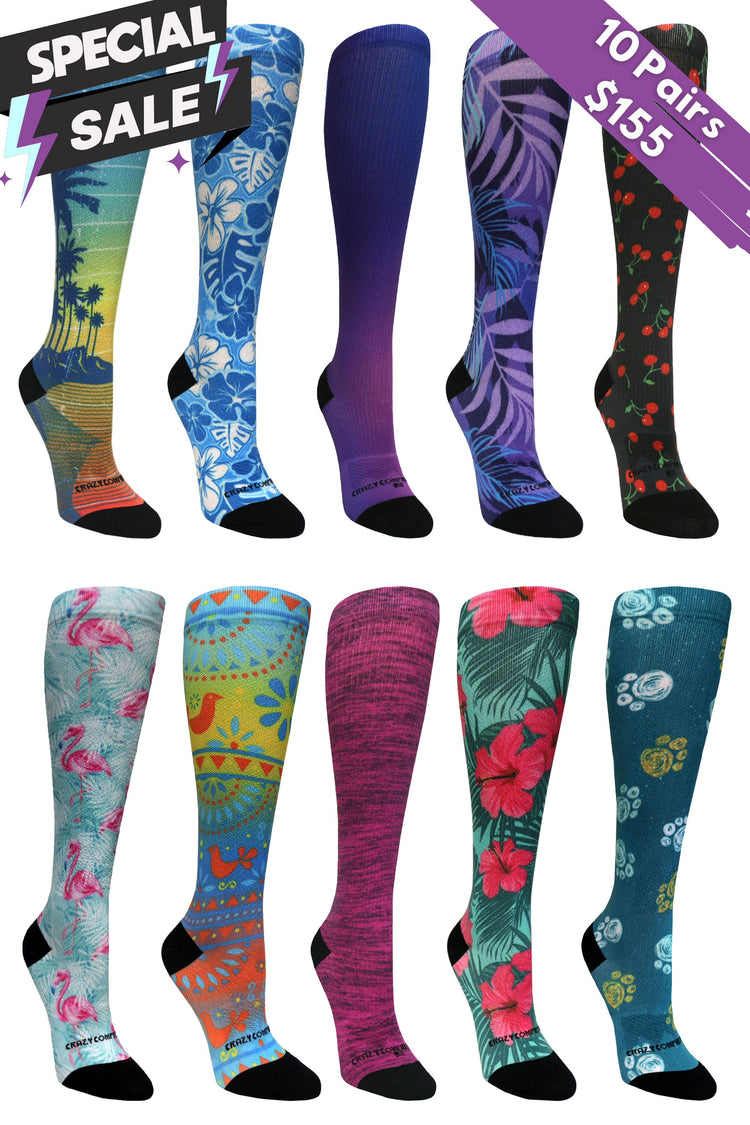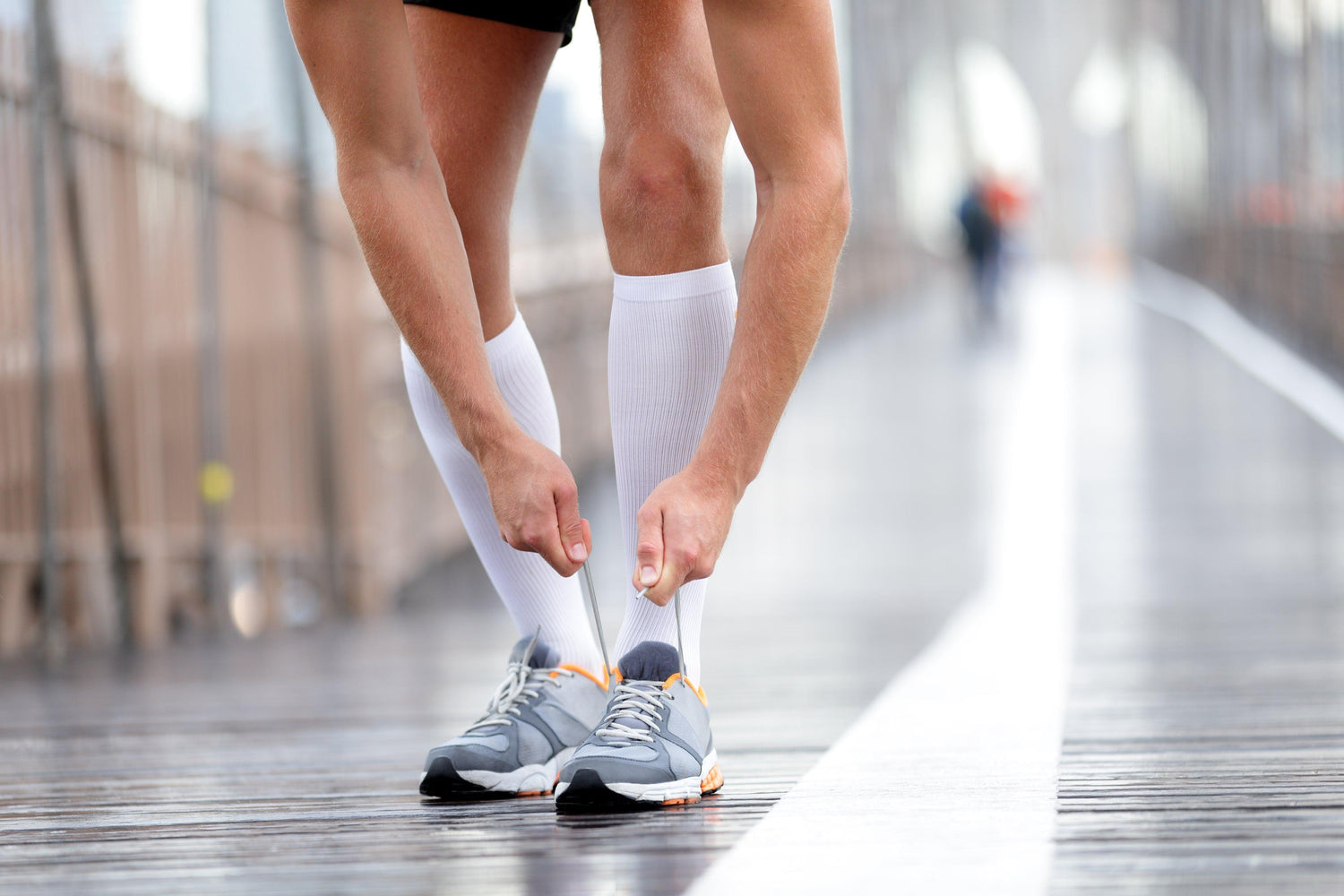You may notice a dull ache in your lower leg during a morning run or after a long day on your feet. This pain could be a sign of shin splints. Knowing the causes and treatment options, including whether compression socks help shin splints, is crucial for managing this common issue. Footwear like cushioned compression socks can provide additional support and comfort, reducing the impact on your shins and alleviating pain more effectively.
What Are Shin Splints?
Shin splints refer to pain along the shin bone (tibia), usually experienced by runners, dancers, or anyone engaging in high-impact activities. Medically known as Tibial Stress Syndrome, shin splints occur when muscles, tendons, and bone tissue in the lower leg become overworked due to sudden changes in physical activity.
Causes of Shin Splints
Flat Feet or Stiff Arches: People with these conditions are more prone to shin splints because their feet cannot correctly absorb shock, putting more strain on the shinbone.
Weak Calf Muscles: Weak calves can put extra strain on the shinbone, which isn't meant to handle such a heavy load, resulting in pain and inflammation. Using supportive gear like compression socks for wide calves can help distribute pressure more evenly and alleviate discomfort.
Symptoms of Shin Splints
Recognizing the symptoms of shin splints early can help you take preventive measures before the condition worsens. Common signs to watch out for include:
- Pain Along the Shinbone - A dull or sharp pain along the inner part of your lower leg, especially during or after physical activity.
- Tenderness or Soreness - Tenderness or soreness when touching the area around your shinbone. This pain may be present even when you're not active.
- Swelling in the Lower Leg - Mild swelling around the shin, sometimes extending to the ankle and foot.
- Muscle Weakness - A feeling of weakness or instability in your lower leg muscles, making it difficult to maintain balance or perform physical activities.
- Increased Pain with Activity - The pain typically intensifies with activities like running, jumping, or prolonged standing and can decrease during rest periods.
How Do Compression Socks Help Shin Splints?
1. Maximize Blood Flow
Compression socks apply gentle pressure to the lower legs, which promotes better blood circulation. Improved circulation ensures more oxygen and nutrients reach the affected area, speeding up healing.
2. Relieve Pain
Compression socks can help reduce pain by minimizing inflammation and supporting the muscles and tendons in the lower leg. They also aid in flushing out lactic acid, which can cause muscle soreness.
3. Boost Performance
Wearing workout compression socks during activities can help prevent shin splints by reducing muscle fatigue and improving efficiency. Enhanced blood flow can also make your movements more effective and less tiring.
4. Reduce Swelling and Stiffness
Wear mild compression socks that apply consistent but gentle pressure to the affected area, keeping fluid from accumulating. This will prevent swelling and stiffness in the area.
5. Speed Up Recovery
The benefits of compression socks—improved blood flow, reduced swelling, and pain relief—all contribute to a faster recovery time for shin splints.
Choosing the Right Compression Garment for Shin Splints
Compression Socks: These cover the entire foot and calf, making them ideal if you experience foot and shin pain.
Compression Sleeves: Focusing on the calf and shin areas, compression leg sleeves allow you to wear your regular socks. They're a good option if your pain is localized to the shin area.
How to Use Compression Socks Effectively for Shin Splints
Wear Them During Physical Activity
There are many surprising benefits of wearing compression socks during a workout. Compression socks provide support during exercise and help prevent shin splints by reducing muscle vibration and fatigue.
Use Them Post-Workout
Wearing compression socks after exercise can aid recovery by improving circulation and reducing muscle soreness.
Choose the Right Size and Compression Level
Compression socks should fit snugly but be tight enough. Choose the correct compression level and consult a sizing chart to ensure you select the proper size and compression level for your needs.
Shin Splint Prevention Tips
Warm Up Properly
- Dynamic Stretching: Engage in leg swings, high knees, or butt kicks to get your muscles warmed up and blood circulating.
- Targeted Muscle Activation: Perform calf raises and ankle circles to activate and strengthen lower leg muscles.
- Gradual Intensity Increase: To avoid sudden strain, start with a brisk walk or light jog before progressing to more intense activities.
Wear the Right Footwear
- Supportive Shoes: Select shoes with good arch support and shock absorption to reduce the impact on your legs.
- Proper Fit: Ensure your shoes fit well, with enough toe box room and secure heel support.
- Custom Insoles: Custom-made insoles are used for additional support and to improve foot alignment, reducing the risk of shin splints.
Gradually Increase Activity Levels
- Follow the 10% Rule: Increase your weekly activity level by no more than 10% to avoid overworking your muscles.
- Cross-Training: Include low-impact activities like swimming or cycling to build strength without adding excessive stress on your legs.
- Rest Days: Include rest days in your routine to allow your muscles and bones to recover and adapt to increased activity.
The Best Stretches for Shin Splints
Gastrocnemius Calf Stretch
- Stand facing a wall with one foot in front of the other.
- Keep your back leg straight and heel on the ground.
- Lean forward and hold for 30 seconds.
- Repeat on the other leg.
Seated Ankle Dorsiflexion Stretch
- Sit on the floor with your legs extended.
- Loop a towel or exercise band around the ball of your foot.
- Gently pull back, keeping your leg straight, and hold for 10 seconds.
- Repeat on the other foot.
Achilles Tendon Stretch
- Stand with your toes on the edge of a step.
- Lower your heel until you feel a stretch in your calf.
- Hold for 30 seconds and repeat on the other leg.
Frequently Asked Questions
Can Compression Socks Help with Shin Splints?
Yes, compression socks can help alleviate shin splint pain by improving blood flow, reducing swelling, and supporting the muscles and tendons in the lower leg.
How Do I Choose the Right Compression Level?
A moderate compression level (15-20 mmHg) is generally adequate for shin splints. Consult a healthcare professional for personalized advice.
Can Shin Splints Go Away Without Treatment?
Shin splints can heal independently with rest, but proper treatment, including stretching and compression, can speed up recovery.
Is It Okay to Run with Shin Splints?
Resting and avoiding high-impact activities when experiencing shin splints is best to prevent further injury.
































Leave a comment
This site is protected by hCaptcha and the hCaptcha Privacy Policy and Terms of Service apply.